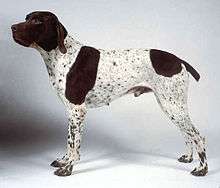Braque Francais
 Male Braque Francais of type Gascogne | |||||||||||||||||||
| Other names |
French Pointing Dog - Gascogne Type; Braque Francais, de Grande Taille | ||||||||||||||||||
|---|---|---|---|---|---|---|---|---|---|---|---|---|---|---|---|---|---|---|---|
| Origin | France | ||||||||||||||||||
| |||||||||||||||||||
| |||||||||||||||||||
| Domestic dog (Canis lupus familiaris) | |||||||||||||||||||
 Male Braque Francais of type Pyrenees | |||||||||||||||||||
| Other names |
French Pointing Dog - Pyrenean Type; Braque Francais, de Petite Taille | ||||||||||||||||||
|---|---|---|---|---|---|---|---|---|---|---|---|---|---|---|---|---|---|---|---|
| Origin | France | ||||||||||||||||||
| |||||||||||||||||||
| |||||||||||||||||||
| Domestic dog (Canis lupus familiaris) | |||||||||||||||||||
The Braques français are hunting dogs, from a very old type of gun dog used for pointing the location of game birds for a hunter. There are two breeds of Braque français, both from the south of France,[1][2] the Braque français, type Gascogne (French Pointing Dog - Gascogne type, larger size) and the Braque français, type Pyrénées (French Pointing Dog - Pyrenean type, smaller size) They are popular hunting dogs in France, but are seldom seen elsewhere.
History
The original Braque français type of pointing dog has existed since the fifteenth century. Over the centuries the dogs were taken to other countries and were crossed with other breeds. When a search was made at the end of the nineteenth century to find the original dogs, two separate regional varieties were found.[3] They may be descended from the Old Spanish Pointer or Pachon Navarro, and the now extinct Southern Hound.
The first breed club was formed in 1850, and the standards for both breeds were written in 1880. It is recognised in its home country by the French Kennel Club (Société Centrale Canine, S.C.C) and internationally by the Fédération Cynologique Internationale.[1][2] The S.C.C. prohibits inbreeding or linebreeding and will not register any dog with common ancestors in the first three generations of its pedigree.[4] Of the major kennel clubs in the English-speaking world, only the Canadian Kennel Club in Canada and the United Kennel Club in the U.S. recognise them. The Canadian Kennel Club recognises one breed, the Braque Français (Gascogne) in its Sporting Dogs Group[5] and the United Kennel Club recognises both breeds, in its Gundog Group, with the names Braque Francais De Grande Taille and Braque Francais, De Petite Taille - petite taille (smaller size) means the Pyrenean is smaller than the Gascogne, and does not mean that it is a little dog.[6][7] The breeds are also recognized by many minor registries, hunting clubs, and internet-based dog registry businesses under various versions of the names, and promoted as rare breeds for those seeking unique pets.
Hunting use
The Braque français breeds are not just pointers, but versatile hunting dogs that can retrieve, flush, and even trail game in all sorts of terrain.[8] The Pyrénées is a quick dog that can move fast without sprinting, while the Gascogne is a slower moving dog.[4]
Appearance
Both breeds of Braque français are medium to large sized dogs with long legs and long drop ears. The coat is short, and chestnut brown or white speckled with brown in colour, often with one or more large brown spots. The head is usually brown. The Gascogne is about 10 centimetres (3.9 in) taller at the withers than the Pyrenean.
Differences
- The Braque français, type Pyrénées dogs are 47–58 centimetres (19–23 in) at the withers, females slightly smaller), giving the impression of "a German shorthaired pointer shrunk down to Brittany size".[4] The larger Braque français, type Gascogne dogs are 58–69 centimetres (23–27 in) (females smaller)
- The coat of the Gascogne is thick, while that of the Pyrénées is described as "finer and shorter" than the Gascogne.[9] The Pyrénées is usually more mottled brown on the body.
- The head of the Pyrénées is slightly broader, and the ears are not as long. On the Gascogne, if the ears are pulled forward, they will reach the tip of the nose. The Gascogne has slightly pendulous lips, making the muzzle appear square; the Pyrénées muzzle looks more narrow.[3]
Faults (elements of appearance that indicate that the dog should not be bred) in both breeds include no tail (anury), split nose or depigmented nose, syndactyly (toes grown together), surplus toes, or absence of toes.
Health
No specific diseases or claims of extraordinary health have been documented for this breed.
Temperament
Ideal Braque Francais temperament is described as "friendly, sociable, gentle and submissive" and, as a soft breed, should not be subjected to harsh training methods.[4] Temperament of individual dogs can vary, and all dogs must be well socialized with people and other animals at an early age in order to be a good pet.
See also
References
- 1 2 "FCI Standard No 133" (PDF). Federation Cynologique Internationale. 7 August 1998. Retrieved 9 December 2014.
- 1 2 "FCI Standard No 134" (PDF). Federation Cynologique Internationale. 7 August 1998. Retrieved 9 December 2014.
- 1 2 Clark, Anne Rogers; Andrew H. Brace (1995). The International Encyclopedia of Dogs. Howell Book House. pp. 146–147. ISBN 0-87605-624-9.
- 1 2 3 4 Braque Francais, The French Pointer In North America, by Chad Mason, Gun Dog Magazine, August, 2004 online Archived May 7, 2008, at the Wayback Machine.
- ↑ "Braque Français (Gascogne)". Canadian Kennel Club. Retrieved 9 December 2014.
- ↑ "Braque Francais, de Grande Taille". United kennel Club. 2006. Retrieved 9 December 2014.
- ↑ "Braque Francais, de Petite Taille". United kennel Club. 2006. Retrieved 9 December 2014.
- ↑ Club du Braque français, breed club in France Archived May 2, 2009, at the Wayback Machine.
- ↑ Breed standard, Braque français, type Pyrénées Archived June 22, 2007, at the Wayback Machine.
Additional reading
- The encyclopedia of the Dog by Bruce Fogle, D.V.M. First American Edition, 1995
- The encyclopedia of Dog Breeds by Juliette Cunliffe, published in 2002
- Pointing Dog Breeds